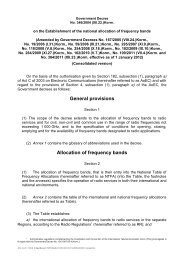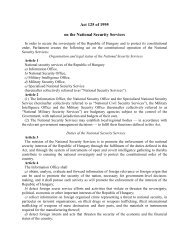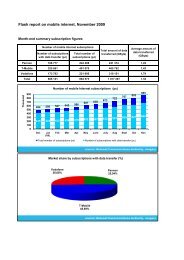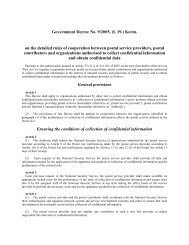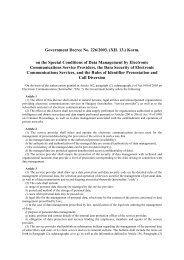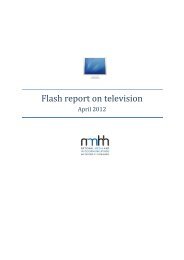The Hungarian Communications Market Developments and ...
The Hungarian Communications Market Developments and ...
The Hungarian Communications Market Developments and ...
You also want an ePaper? Increase the reach of your titles
YUMPU automatically turns print PDFs into web optimized ePapers that Google loves.
<strong>The</strong> <strong>Hungarian</strong> <strong>Communications</strong> <strong>Market</strong> <strong>Developments</strong> <strong>and</strong> Regulation between 2004 <strong>and</strong> 2008<br />
growth of the share of alternative service providers in Hungary was<br />
significantly higher than the EU average. On the basis of the above<br />
information, it can be established that the <strong>Hungarian</strong> traffic market has<br />
dynamically approached the EU average between 2004 <strong>and</strong> 2006.<br />
<strong>The</strong> <strong>Hungarian</strong> indices show that before 2004 incumbent service<br />
providers have managed to delay competition successfully. <strong>The</strong><br />
harmful effects of this are observable even today, as it is safe to say<br />
that the later it comes to entry into the market, the less chance there<br />
is for fierce competition to develop.<br />
In the fixed access markets of all EU Member States competition<br />
developed only very slowly. <strong>The</strong> past few years have, however, brought<br />
about some changes also in this respect. Essentially due to the growth<br />
of the DSL market, fixed access became more attractive for alternative<br />
service providers. In addition, the provision of voice communications<br />
through cable television infrastructure also became economically feasible,<br />
which significantly contributed to the strengthening of competition<br />
in the fixed access markets in those Member States with significant<br />
cable television penetration. In respect of the EU average, the ratio of<br />
consumers using access provided by alternative service providers has<br />
nearly doubled between 2005 <strong>and</strong> mid-2007.<br />
Figure 4.7: Ratio of consumers using access provided by alternative<br />
service providers<br />
%<br />
14<br />
12<br />
10<br />
8<br />
6<br />
4<br />
2<br />
0<br />
6,1<br />
0,6<br />
EU average<br />
HU<br />
PL<br />
SK<br />
SL<br />
CZ<br />
7,9<br />
3,0<br />
2004 2005 2006<br />
2007<br />
Source: NHH <strong>and</strong> EU Implementation Reports 11, 12, 13<br />
In this period, Hungary has also seen a dynamic development,<br />
with the hardly noticeable share of alternative service providers in<br />
2004 almost reaching nine percent by 2007. This value was somewhat<br />
higher than EU average growth. Making a regional comparison,<br />
only the Polish index was better than the <strong>Hungarian</strong>. However, it is<br />
9,5<br />
5,5<br />
13,5<br />
8,8<br />
also noticeable that competition in the retail access market has also<br />
been developing at a notable pace in other countries of the region.<br />
In Hungary, it is mainly the cable television service providers that<br />
generate access market competition. On the contrary, the role of<br />
alternative service providers competing through unbundled access<br />
to the local loop is much less marked than in a number of other<br />
European countries.<br />
In 2007, Teligen dealing with the comparison of communications<br />
prices estimated monthly spending relating to the consumer baskets<br />
(newly) defined by the OECD (three residential <strong>and</strong> two business<br />
consumer baskets), assuming that in the given consumer structure,<br />
rational consumers opt for the optimal tariff-package of the incumbent<br />
service provider.<br />
<strong>The</strong> spending of <strong>Hungarian</strong> consumers with low (600 calls per<br />
year) <strong>and</strong> medium (1200 calls per year) traffic (in both cases using<br />
Tariff Package “Felezô”) is in nominal terms among the lowest ones<br />
in Europe. <strong>The</strong> spending of residential consumers with significant<br />
traffic (2400 calls per year) in Hungary, using Tariff Package “Favorit”,<br />
is in the middle of the pack. At the same time it is likely that,<br />
with Tariff Package “Favorit nonstop plusz” introduced meanwhile<br />
by Magyar Telekom for consumers with large traffic, the <strong>Hungarian</strong><br />
value of the service would have been significantly lower. Also in the<br />
case of the consumer basket for micro-enterprises, the <strong>Hungarian</strong><br />
value is the lowest one in Europe (Package “Grátisz 500”). This offer,<br />
even in the case of small <strong>and</strong> medium enterprises, is among the<br />
cheaper ones <strong>and</strong>, in terms of purchasing power parity, the <strong>Hungarian</strong><br />
values would be in the middle of the pack or characteristic for<br />
more expensive countries.<br />
Summary<br />
On the basis of the assessment of the effects of regulation, it can be<br />
established that after 2004 positive developments have started also in<br />
fixed traffic markets. <strong>The</strong> share of alternative service providers began<br />
to dynamically grow, with Hungary’s underdevelopment significantly<br />
diminishing as compared to the EU average. Prices also decreased, thus<br />
making consumers able to experience the advantageous effects of both<br />
lower prices <strong>and</strong> greater choice. <strong>The</strong> intensification of competition <strong>and</strong><br />
the processes beneficially influencing consumer prosperity are essentially<br />
due to the obligations imposed by the Board in line with the Eht., in particular<br />
to the decrease of interconnection tariffs from the previously high<br />
level to around EU average. NHH has also enforced the improvement<br />
of non-price conditions of interconnection, which facilitated the entry of<br />
alternative service providers into the market.<br />
Indices of the fixed access market investigated are not as bright as in the<br />
case of traffic markets. It is true that the access market competition did<br />
make a forceful start also in Hungary, this was owing to factors beyond<br />
the scope of regulation, primarily the entry of cable service providers into<br />
the market within the framework of the 3-play strategy.




